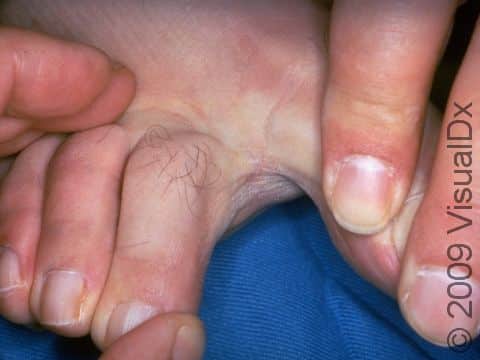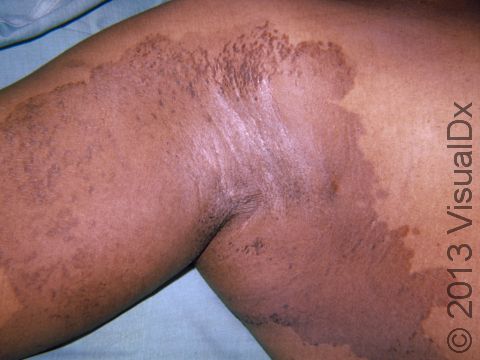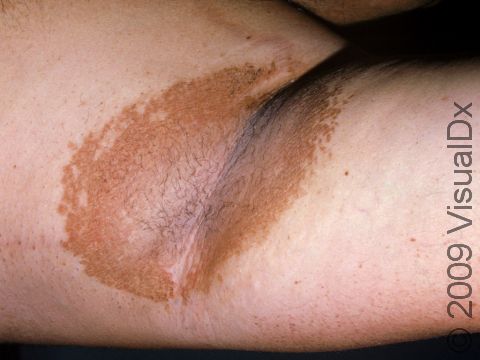Erythrasma
Erythrasma is a common skin condition caused by infection with the bacterium Corynebacterium minutissimum. It appears as slowly enlarging patches of brown or pink, slightly scaly skin, usually in the skin folds, but other skin surfaces can be affected. Some people only get it once, while others seem to get it over and over. Sometimes there are no symptoms other than the rash, and sometimes the affected areas itch.
Who's At Risk?
Erythrasma can affect people of any age or race / ethnicity, but it is more common among people who live in warm, humid climates, especially tropical areas. Children aged 5-14 years make up 15% of those infected with erythrasma. It occurs more often in older individuals, so it is seen more frequently in teens and adults than children. Males and females are affected equally.
The following conditions may increase the likelihood of getting erythrasma:
- Diabetes
- Obesity
- Excessive sweating
- Poor hygiene
- A weak immune system (immune deficiency)
Signs & Symptoms
Erythrasma appears as one or more patches (flat, smooth areas of skin larger than a thumbnail) of brown, pink, or red, slightly scaly skin. It is often symmetrical (eg, affecting both underarms or both sides of the groin). The border of erythrasma is well-defined, meaning affected areas look clearly different from the surrounding normal skin. Over time, the patches fade to tan or brown.
Erythrasma is typically located in moist body folds such as:
- The underarms.
- The groin and inner thighs.
- Between the toes, especially between the 4th and 5th toes.
Less commonly, erythrasma can be found in the buttock crevice or in the folds underneath the breasts, if there is skin-on-skin contact. In some people, especially those with diabetes, the infection can become widespread, affecting the trunk, arms, and legs.
Erythrasma usually causes no symptoms, but some people report mild itching or burning, especially in the groin area.
Self-Care Guidelines
If you suspect your child has erythrasma, they can:
- Gently wash the involved area with antibacterial soap (eg, Dial antibacterial bar soap), which can help treat active infections and prevent future infections.
- Keep the involved area dry.
- Dress in loose clothing.
Treatments
Once the diagnosis of erythrasma is confirmed, the medical professional may try:
- Topical antibiotic lotions such as erythromycin or clindamycin.
- Oral antibiotics such as erythromycin.
Visit Urgency
See your child’s medical professional if the affected skin does not improve with self-care measures.
References
Bolognia J, Schaffer JV, Cerroni L. Dermatology. 4th ed. Philadelphia, PA: Elsevier; 2018.
James WD, Elston D, Treat JR, Rosenbach MA. Andrew’s Diseases of the Skin. 13th ed. Philadelphia, PA: Elsevier; 2019.
Kang S, Amagai M, Bruckner AL, et al. Fitzpatrick’s Dermatology. 9th ed. New York, NY: McGraw-Hill Education; 2019.
Paller A, Mancini A. Paller and Mancini: Hurwitz Clinical Pediatric Dermatology. 6th ed. St. Louis, MO: Elsevier; 2022.
Last modified on June 17th, 2024 at 1:26 pm

Not sure what to look for?
Try our new Rash and Skin Condition Finder


